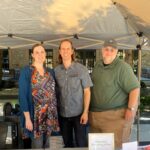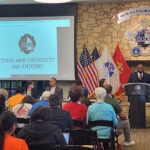
By Melody Mendoza
President Maria Hernandez Ferrier led a meeting with government officials, Texas A&M-University System administrators and A&M-San Antonio administrators Oct. 26 to present the university’s continuous growth, an outcome of investment and support over the last decade.
The officials were those who played key roles in awarding the university its $40 million tuition revenue bond to build Main Campus Building. A video presentation of building details and student testimonials was presented during the meeting so officials could see the outcome of their decisions and support the university’s growth.
Greg Garcia, assistant vice chancellor for governmental relations of the A&M-University System, said the meeting was to give “an overview of how we’ve invested the appropriations they’ve given us over 10 years.”
Garcia, an early supporter of A&M-San Antonio, worked closely with the late Sen. Frank Madla,
from Texas, who in 1997, requested proposals to establish a university on the South Side of San Antonio.
“He was the person that egged him (Madla) along. Greg was his best friend,” Dr. Stanton Calvert, vice chancellor for governmental relations of the A&M-University System, said.
Garcia explained that there were staff members from the committees of the House of Appropriations, Legislative Budget Board, Senate Finance, Government Office, Lieutenant Government Office and Bexar County Delegation.
The idea was to “prepare them without having to ask them for funding until the 83rd legislative session,” he said.
Administrators here have realized that a second building is crucial for a growing university.
Dr. Charles “Chuck” Rodriguez, vice president for strategic initiatives, institutional advancement and military affairs, said it’s “ever more critical to get more buildings … when we’re all together, you stand for something.”
Also, Ferrier said in her presentation that it’s “important to bring everything to one campus.”
Right now, A&M-San Antonio has classes and staff at four campuses — Main Campus at One University Way and Brooks City-Base Campus, which Ferrier said is about 15 miles from Main Campus at 2601 Louis Bauer Dr, and Gillette Campus at 1450 Gillette Blvd.
Gillette Campus, about 3 miles from Main Campus, is currently a security presence, but several divisions of finance and administration — payroll, accounting, procurement and human resources — will move to offices starting Monday, Jill Reddish, university communications specialist, said.
Classes also are offered at Alamo University Center, 32 miles from Main Campus. Five other institutions offer classes there also, and A&M-San Antonio has the largest use alongside of Wayland Baptist University.
Ferrier explained that this semester, the university tried to keep programs in one building to minimize students having to drive to multiple campuses.
Enrollment growth led administrators to search for a second location, dividing faculty, staff and students between two major campuses — Main Campus and Brooks campuses.
Also, enrollment has grown 148 percent since 2008 and 14 percent in the last year, according to Ferrier’s presentation, which is the fastest rate of growth of the 11 universities in the A&M-System. Therefore, expansion will be necessary to accommodate enrollment growth.
Ferrier said she anticipates enrollment leveling off at 15 percent in the next few years.
A reason for the enrollment growth is the university’s affordability, Ferrier said, referring to students’ comments in the video shown.
Compared to nearby public universities, A&M-San Antonio’s tuition is almost $1,000 cheaper per semester.
Officials there asked Ferrier how the university will plan to keep tuition affordable.
She said although the university has increased fees in the last year, the university has implemented cost-effective printing and shared services.

But Kenneth Mitts, vice president for finance and administration, said it will be difficult to keep tuition and fees low because the university has no financial reserves.
“The money has to come from somewhere,” he said. “And that’s the struggle we’re in right now.”
He added that if university grows, that brings in more revenues, which will create less financial strain as money comes in, but there is a chance tuition and fees will increase.
He said the university relied on the state for 70 percent of its funding in fiscal year 2011. And Ferrier added that special funding is not special funding because it’s base funding for the university.
Also, Mitts said the university will apply for its accreditation in February, which will allow this university to award its own financial aid.
Ferrier said the university started a foundation three years ago to raise money for scholarships, which helps keep the financial load off of students.
To support the need for funds, Ferrier presented statistics to show the university’s growth and progress:
• The university is made up of 63 percent Hispanic students, 24 percent Anglo and 6 percent African Americans.
• There are more female students; 68 percent compared to 32 percent of males.
• She explained that students are coming from the Alamo Colleges, which have an enrollment of about 60,000 students, and other universities.
An issue that university administrators saw during the planning stages of the campus was that community college students had over 100 hours, but didn’t have the means to transfer to UTSA, which is across town for students at Palo Alto College.
This university has given students another opportunity, like UTSA did when it opened, Ferrier said.

Rodriguez added that many students are reentries, who have been in the workforce or military, and have returned to earn a degree.
“That’s why the average age is high,” he said.
• Ferrier said the average age is 31 years old, and many students have full-time jobs and children. Therefore, the campuses are full in the evenings.
Ferrier mentioned her visit to the Board of Regents meeting Nov. 3 to request approval of Spanish and community health programs.
• The university began offering graduate degrees two years ago. And, the university has acted as a feeder to A&M-College Station for its graduate degrees that are not offered here.
• The three schools — School of Business, School of Arts and Sciences and School of Education and Kinesiology — have also seen increases.
The School of Business has 900 student majors and its master’s of business management degree has had a 33 percent enrollment increase.
The education program is a signature program for the university, Ferrier said.
The School of Education will be working with 12 school districts, and for five years, the university will monitor the students of A&M-San Antonio’s student teachers to see their success, Ferrier explained.
This is to ensure that student teachers are being properly informed about what qualities and education is needed for school teachers.
Through this pilot, the university began working with Alamo Colleges education, math, reading and English classes to implement change at the college level.
• Ferrier also noted the increase of student engagement in the last three years. There was an increase from two student organizations to more than 30 this semester.
She explained that today, the university has a good relationship with Alamo Colleges and UTSA, has been reaching out to the community and continues to find new ways to get students through to graduation.
The university is hosting community speakers, and will continue making the environment better by posting new light poles with A&M-San Antonio banners along University Way.






